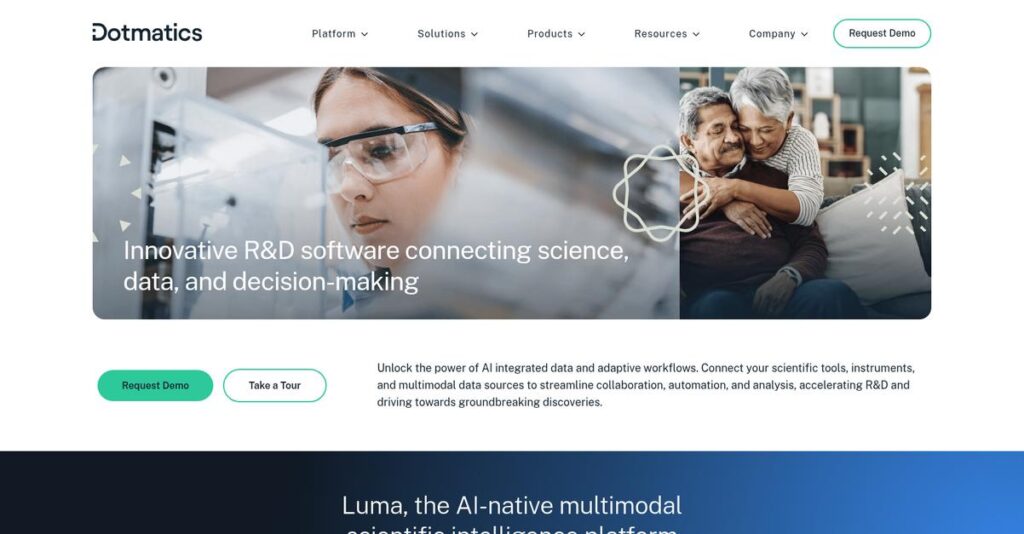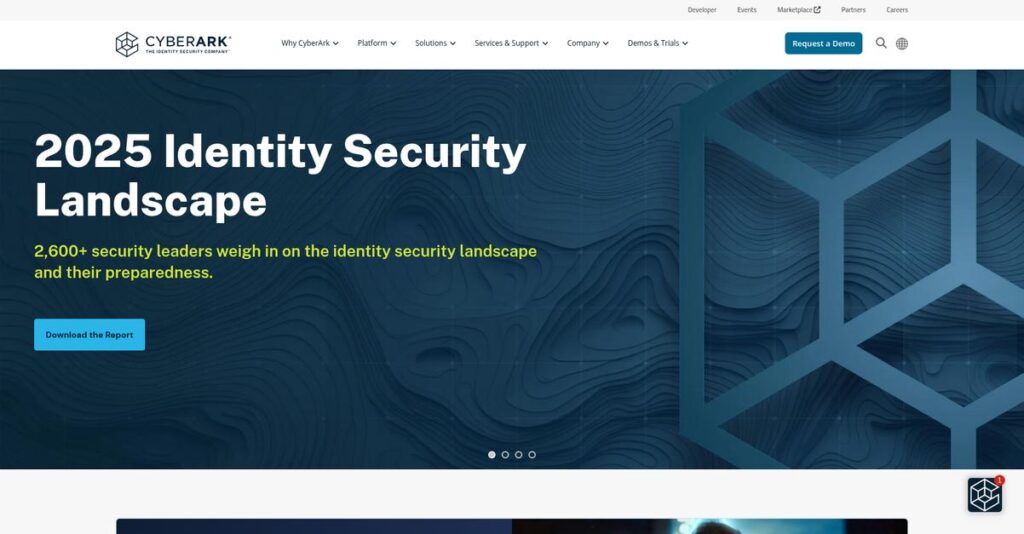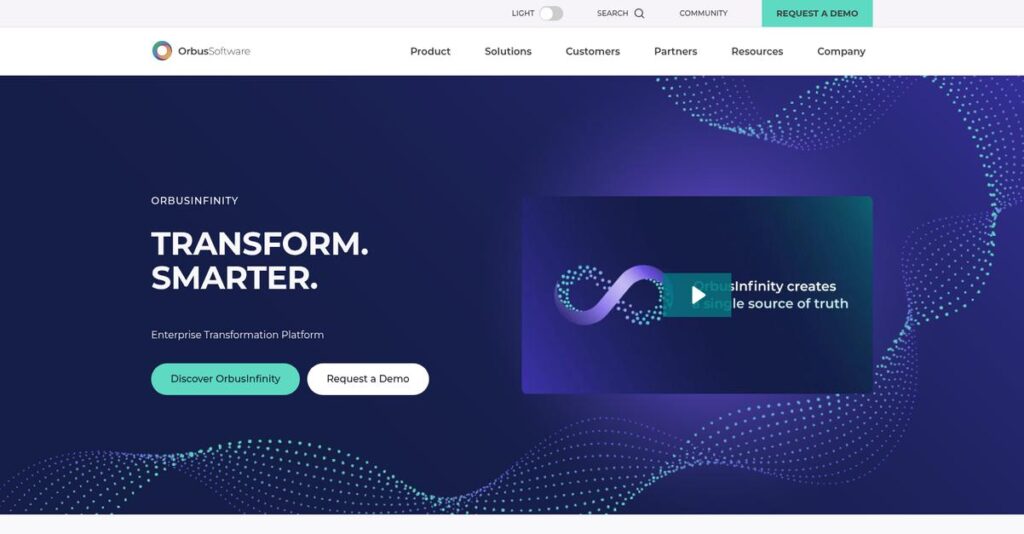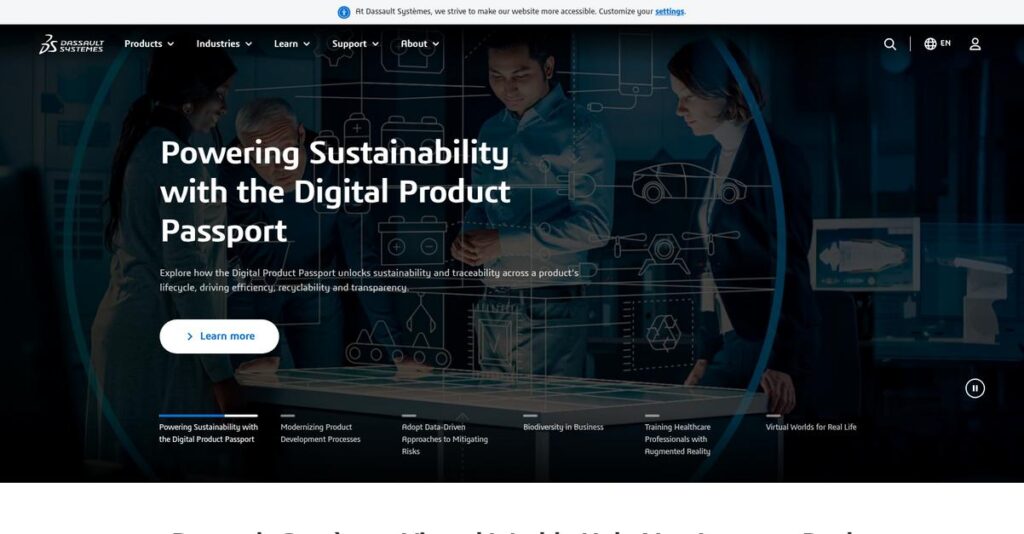Too much scientific data, not enough clarity?
If you’re dealing with scattered R&D workflows and frustrated by messy data from different instruments, evaluating solutions like Dotmatics becomes a real priority.
Chances are, you’re wrestling with the constant confusion of disjointed lab data—which is draining your productivity and holding back vital decisions.
What stood out to me about Dotmatics is its AI-powered Luma platform, which actually brings all your lab’s data and workflows into one place without the usual manual effort. With tightly integrated electronic lab notebooks, data visualization, and specialized modules for both molecular biology and chemistry, Dotmatics really tackles that chaos at the source.
In this review, I’ll break down how Dotmatics helps you actually organize and use your R&D data instead of just drowning in it.
You’ll discover in this Dotmatics review how the platform’s features, user experience, pricing, and alternatives fit into your evaluation process—so you can see how it stacks up to your expectations.
You’ll walk away with clear insights on the features you need to confidently make the right decision for your lab.
Let’s get started.
Quick Summary
- Dotmatics is an integrated R&D scientific software platform that centralizes and automates data and workflows for life sciences research.
- Best for organizations needing flexible, customizable solutions to manage diverse scientific data and streamline R&D processes.
- You’ll appreciate its AI-powered platform that simplifies data integration and helps your team reduce manual errors and improve collaboration.
- Dotmatics offers custom enterprise pricing with no free trial, requiring direct contact for tailored quotes based on users and modules.
Dotmatics Overview
Dotmatics has been a key player in scientific R&D software since its founding in 2005. Now based in Boston, their mission is connecting science, data, and critical decision-making.
They primarily target life sciences and biopharma R&D, serving over two million scientists globally. You’ll find their platform is intentionally built to unite disparate research tools, so your teams aren’t left stitching multiple complex systems together.
The planned $5.1B acquisition by Siemens is a significant strategic move. I think this will accelerate AI and Digital Twin integration, a key point we’ll explore through this Dotmatics review.
Unlike competitors like Benchling, often praised for usability, Dotmatics provides a more comprehensive cross-discipline platform. Their superior chemistry tools and broad instrument integration feel built for complex, multi-modal enterprise research from the ground up.
They work with top biopharma enterprises, chemical firms, and prominent academic institutions. This shows me the solution can readily scale from pure exploratory research to highly regulated industrial workflows.
I see their current strategy centering on the Luma platform to deliver tangible, AI-powered insights. This directly addresses the market’s urgent need for accelerated discovery, likely a top priority for your own R&D team.
Let’s dive into their core features.
Dotmatics Features
Struggling to connect your scattered scientific data?
Dotmatics solutions provide an integrated R&D platform designed to streamline scientific workflows. These are the five core Dotmatics solutions that address key challenges in modern scientific discovery.
1. Dotmatics Luma Scientific Intelligence Platform
Drowning in disparate scientific data?
Collecting and making sense of instrument data across various sources can be a real headache, slowing down crucial insights.
Luma simplifies this by acting as your central AI-powered data management hub, effortlessly processing hundreds of terabytes of raw data. It curates data automatically using business rules, which I found incredibly efficient for unifying diverse datasets. This solution helps non-technical users gain rapid insights.
This means you can finally centralize your information for improved efficiency and smarter decision-making, without the data chaos.
- 🎯 Bonus Resource: Speaking of specialized software, my guide on best civil engineering software can help pinpoint your fit.
2. Electronic Lab Notebook (ELN) & Data Discovery
Is tracking experimental data still a manual nightmare?
Recording observations and collating unstructured data can quickly become overwhelming, hindering collaboration and report generation.
The Dotmatics ELN centralizes your experimental notes, enabling you to customize complex analysis workflows and track all data edits. What I love is how its enhanced user interface streamlines data input and output, making scientific tasks less administrative. It really facilitates seamless collaboration.
So you and your team can manage and interact with data more efficiently, reducing administrative burdens and accelerating research.
3. Biology Solution
Are your biologics research efforts bogged down by data silos?
Managing complex biological data across molecular cloning, vector design, and protein production often requires specialized expertise, creating bottlenecks.
This solution provides an end-to-end tool specifically for biologics data management, offering robust visualization and bioinformatics capabilities. From my testing, it enables rapid insights into complex biological data without needing a dedicated bioinformatician. It accelerates every step from discovery to registration.
This means your team can swiftly analyze and understand complex biological information, driving faster breakthroughs in biopharma and AgTech.
4. Small Molecule Drug Discovery Solution
Is small molecule R&D slowing your path to new therapies?
Streamlining drug discovery workflows can be incredibly challenging, especially when trying to enhance insights and foster collaboration in chemistry.
Launched to accelerate this process, this solution enhances insights and collaboration within chemistry research, including advanced compound registration. This is where Dotmatics shines, providing a focused platform for improving small molecule R&D processes. It empowers researchers to move discoveries forward more quickly.
The result is your team can accelerate the discovery of life-improving therapies by making the entire R&D process more efficient and collaborative.
5. GraphPad Prism
Tired of static data analysis and limited graph options?
Analyzing scientific data and creating publication-ready graphs can be frustrating if your tools lack flexibility and integration.
GraphPad Prism, integrated into the Dotmatics portfolio, offers powerful statistical analysis and 2D graphing with extensive customization. What I appreciate is its new open file format for improved collaboration and integration capabilities. This feature helps scientists visualize results beautifully.
This means you can make data-driven decisions faster and produce high-quality visuals for presentations and publications with ease.
Pros & Cons
- ✅ Provides a truly end-to-end solution for diverse R&D scientific workflows.
- ✅ Highly flexible and customizable to meet unique departmental needs and preferences.
- ✅ Centralizes disparate scientific data, significantly improving collaboration and access.
- ⚠️ The platform’s extensive functionality and setup can present a steep learning curve.
- ⚠️ Some administrative tasks are surprisingly detailed and may require support assistance.
- ⚠️ Transparent pricing is not publicly available, requiring direct sales engagement.
You’ll appreciate how these Dotmatics solutions work together, providing a cohesive and unified R&D platform. The integrated Dotmatics features ensure seamless data flow and enhanced decision-making across your entire scientific enterprise.
Dotmatics Pricing
Wondering about the true cost?
Dotmatics pricing employs a custom enterprise model, meaning you’ll need direct engagement with their sales team to understand the cost structure for your specific needs.
Cost Breakdown
- Base Platform: Custom quote (requires direct sales contact)
- User Licenses: Per-user basis, potential volume discounts
- Deployment Model: Varies by Cloud (SaaS) or On-Premise option
- Specific Solutions and Modules: Cost influenced by ELN, LIMS, Biology/Chemistry solutions
- Key Factors: Number of users, deployment model, required modules, implementation, support
1. Pricing Model & Cost Factors
Their pricing approach is custom.
Dotmatics’ pricing is based on a custom quote model, meaning there are no public tiers, and costs are tailored to your specific requirements. Your overall cost depends on the number of users, specific modules like ELN or LIMS, and whether you choose cloud or on-premise deployment. From my cost analysis, implementation and advanced support can also add significantly to the budget.
This means your budget aligns directly with the solutions you truly need, rather than fixed, generic packages.
- 🎯 Bonus Resource: Speaking of specialized software, you might find my guide on best foster care software helpful.
2. Value Assessment & ROI
How does the value stack up?
Dotmatics’ integrated platform aims to streamline R&D, potentially offering significant ROI by accelerating discovery and improving data management. What stood out is how their solutions can reduce manual data handling and integrate diverse scientific workflows, which saves your team time and reduces errors.
Budget-wise, this means you’re investing in efficiency that can lead to faster breakthroughs and better decision-making.
3. Budget Planning & Implementation
Consider all your expenses.
Beyond the core software, remember to factor in potential implementation costs, especially for complex integrations or specialized consulting. From my research, your total cost of ownership extends beyond licensing fees, incorporating deployment, training, and ongoing support tailored to your unique scientific environment.
So for your business, expect to allocate budget not just for software, but for a comprehensive setup that ensures full operational success.
My Take: Dotmatics’ custom pricing model reflects its enterprise-grade, highly configurable solutions, making it best suited for large R&D organizations needing bespoke scientific software.
The overall Dotmatics pricing reflects a customized investment for complex scientific R&D needs.
Dotmatics Reviews
What do actual users think?
My analysis of Dotmatics reviews offers balanced insights into real user feedback and experiences, providing a clear picture of what customers genuinely think.
1. Overall User Satisfaction
User sentiment is largely positive.
From my review analysis, Dotmatics generally garners positive feedback, especially for its comprehensive R&D capabilities. What impressed me about the feedback is how users often highlight improved data management and streamlined workflows, which often leads to higher satisfaction.
This indicates you can expect a solution that aims to centralize and simplify your scientific data.
2. Common Praise Points
Flexibility and support stand out.
Users consistently praise Dotmatics for its end-to-end solution, flexibility, and strong customer support. From my analysis, the platform’s customization possibilities are a frequent highlight, allowing varied workflows that cater to specific departmental needs in R&D environments.
This means you can expect a highly adaptable system that simplifies collaboration and data management for your team.
3. Frequent Complaints
Complexity and transparency pose challenges.
While powerful, reviews frequently mention a learning curve and complexity during setup and customization. What stood out in customer feedback is how the “tinkery” nature of administrative tasks can be fussy, and finding specific settings might require support.
These challenges suggest that while powerful, the platform might require a dedicated effort to master its full capabilities.
- 🎯 Bonus Resource: Speaking of customization, my guide on hardware and paint software might fuel your creativity.
What Customers Say
- Positive: “It brings all our chemical and biological data together, making collaboration much easier.” (Source: User Review)
- Constructive: “Setting it up can be ‘tinkery,’ and some administrative tasks are surprisingly fussy.” (Source: Administrator Review)
- Bottom Line: “Helped us focus more on scientific work rather than managing logistics, despite the initial learning curve.” (Source: Customer Feedback)
Overall, Dotmatics reviews reflect strong capability with a notable learning curve for comprehensive implementation.
Best Dotmatics Alternatives
Which Dotmatics alternative is right for you?
The best Dotmatics alternatives include several strong options, each better suited for different scientific R&D needs, team sizes, and regulatory environments. I’ll help you decide.
1. Benchling
Focused on molecular biology and intuitive collaboration?
Benchling is often seen as more intuitive and user-friendly, particularly for molecular biology research and quick implementation, especially for smaller teams. From my competitive analysis, Benchling offers a more intuitive user experience and stronger collaboration features in that specific domain.
Choose Benchling if your primary focus is molecular biology and a centralized platform for experiment management.
- 🎯 Bonus Resource: If you’re also looking into different software solutions, my article on best insurance agency software covers a different, but equally important, niche.
2. Thermo Scientific SampleManager LIMS Software
Need robust data storage and strict regulatory compliance?
SampleManager LIMS excels in labs requiring superior capabilities in data storage, advanced querying, and robust document management for strict regulatory compliance. What I found comparing options is that SampleManager LIMS is ideal for regulatory compliance in industries like pharma or environmental.
Consider this alternative if your lab prioritizes comprehensive LIMS for quality management and regulatory adherence.
3. STARLIMS
Operating in highly regulated industries with complex compliance?
STARLIMS excels in compliance features and offers a comprehensive technology platform for seamless integration across various lab systems. From my analysis, STARLIMS provides extensive quality management features and robust compliance, though it typically involves higher implementation costs and a steeper learning curve.
Choose STARLIMS if your organization requires deep compliance capabilities in highly regulated industries, accepting higher costs.
4. IDBS
Seeking deep integration for specific scientific workflows?
IDBS offers scientific informatics solutions, including ELN and LIMS, that directly compete in integrated R&D environments. Alternative-wise, the choice often comes down to specific feature sets, user interface preferences, and the depth of integration required for particular specific scientific workflows.
Choose IDBS when specific integration needs and UI preferences align more closely than Dotmatics’ broader offering.
Quick Decision Guide
- Choose Dotmatics: Unified platform for broad R&D with strong chemistry features
- Choose Benchling: Molecular biology research and intuitive team collaboration
- Choose Thermo Scientific SampleManager: Robust LIMS for strict regulatory compliance
- Choose STARLIMS: Highly regulated industries requiring extensive quality management
- Choose IDBS: Specific workflow integrations and UI preferences matter most
The best Dotmatics alternatives truly depend on your specific R&D focus and compliance needs, not just a feature checklist.
Dotmatics Setup
How complex is Dotmatics implementation, really?
Dotmatics review reveals a comprehensive platform, and like any powerful system, its deployment involves strategic planning. Here’s a practical look at what you’re signing up for.
1. Setup Complexity & Timeline
This isn’t an instant flip of a switch.
Dotmatics implementation often involves customizing workflows and understanding the data schema, especially for new scientific data management users. What I found about deployment is that administrative tasks can be surprisingly fussy and detailed, requiring focused effort rather than quick wins.
You’ll need to plan for dedicated time and potentially external support to navigate these initial configuration complexities.
- 🎯 Bonus Resource: Speaking of visual storytelling, you might find my guide on best whiteboard animation software helpful for presenting complex ideas.
2. Technical Requirements & Integration
Be ready for robust technical integration.
Dotmatics supports both cloud and on-premise deployments, requiring your IT team to manage infrastructure and ensure seamless data flow. From my implementation analysis, robust integration with instruments and third-party software is crucial for a comprehensive data management strategy.
Prepare your IT resources for API-based data exchange, out-of-the-box parsers, and potentially complex scientific data modeling.
3. Training & Change Management
User adoption is key for maximizing value.
The extensive functionality of Dotmatics means a learning curve for new users, necessitating thorough training to leverage its full potential. From my analysis, Dotmatics provides positive training experiences, helping users find the system flexible and intuitive once they’re up to speed.
Invest in comprehensive training programs and identify internal champions to drive successful user adoption and workflow integration.
4. Support & Success Factors
Vendor support significantly impacts success.
Dotmatics boasts “profound support expertise,” with an approachable team “always on standby” to assist with complex settings or data origins. From my implementation analysis, vendor support is critical for navigating detailed setups and ensuring smooth progress.
Factor in proactive engagement with Dotmatics’ support and ensure internal project management to capitalize on their expertise.
Implementation Checklist
- Timeline: Several weeks to months, depending on customization
- Team Size: Project manager, IT, and scientific domain experts
- Budget: Professional services for complex configurations
- Technical: Integration with lab instruments and existing software
- Success Factor: Comprehensive user training and vendor support
The overall Dotmatics setup requires dedicated resources and strategic planning but enables powerful scientific data centralization and R&D efficiency.
Bottom Line
Should you invest in Dotmatics for R&D?
My Dotmatics review reveals a robust scientific software platform best suited for R&D-intensive organizations that require a highly integrated and customizable solution for diverse scientific data.
1. Who This Works Best For
R&D-intensive organizations in life sciences and chemicals.
- 🎯 Bonus Resource: Speaking of software, you might also find my guide on best takeoff software helpful for managing bids.
Dotmatics is ideal for pharmaceutical, biotechnology, and materials companies, as well as academic institutions, that need to centralize scientific data and automate complex lab workflows. From my user analysis, organizations leveraging AI for predictive scientific outcomes will find this platform particularly beneficial for accelerating innovation.
You’ll see great success if your team focuses on interdisciplinary research requiring seamless data management and collaboration.
2. Overall Strengths
Comprehensive integration across scientific disciplines is paramount.
The software excels at connecting diverse scientific data (biology, chemistry, materials) and automating complex R&D workflows, offering a truly end-to-end solution. From my comprehensive analysis, its ability to centralize fragmented scientific data significantly enhances decision-making and project efficiency, setting it apart from competitors.
These strengths mean your organization can streamline research efforts, reduce manual errors, and accelerate time-to-market for new innovations.
3. Key Limitations
Initial setup complexity requires significant investment.
While highly customizable, new users may face a substantial learning curve to fully configure and optimize workflows, which can be time-consuming. Based on this review, administrative tasks can be surprisingly fussy and detailed, requiring dedicated effort to navigate beyond basic functions and settings.
I find these limitations are a trade-off for its powerful capabilities, manageable with proper planning and leveraging Dotmatics’ support.
4. Final Recommendation
Dotmatics is highly recommended for specific enterprises.
You should choose this software if your organization is a mid-market to enterprise-level entity in life sciences, chemicals, or materials, seeking a robust, integrated R&D platform. From my analysis, this solution is best for complex, multi-disciplinary research needing advanced data management, not for simple lab needs.
My confidence level is high for organizations ready to invest in a comprehensive, long-term R&D digital transformation.
Bottom Line
- Verdict: Recommended for R&D-intensive organizations
- Best For: Scientists and researchers in life sciences, chemicals, materials
- Business Size: Mid-market to global enterprises and large academic institutions
- Biggest Strength: Centralized management of diverse scientific data and workflows
- Main Concern: Complexity of initial setup and lack of public pricing
- Next Step: Contact sales for a personalized demo and custom quote
This Dotmatics review shows strong value for the right R&D business, while also highlighting the learning curve and investment required for implementation.





